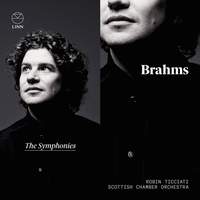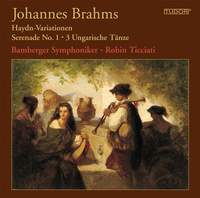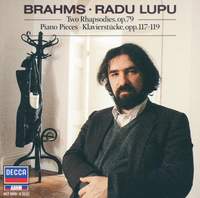Interview,
Robin Ticciati on Brahms's Symphonies
 Following their award-winning set of the Schumann symphonies a couple of years ago, it seemed a natural progression for Robin Ticciati and the Scottish Chamber Orchestra to turn their attention to Brahms – they embarked on a major concert-series exploring his works in autumn 2015, and recently spent what Ticciati describes as ‘three furnace days’ in the studio recording the four symphonies. The results (released on Linn this Friday) are also their final recording together: following almost a decade as their Principal Conductor, Ticciati is now based in Germany where he’s taken up the same position with the Deutsches Symphonie-Orchester Berlin, and gives his farewell concerts in Scotland this weekend.
Following their award-winning set of the Schumann symphonies a couple of years ago, it seemed a natural progression for Robin Ticciati and the Scottish Chamber Orchestra to turn their attention to Brahms – they embarked on a major concert-series exploring his works in autumn 2015, and recently spent what Ticciati describes as ‘three furnace days’ in the studio recording the four symphonies. The results (released on Linn this Friday) are also their final recording together: following almost a decade as their Principal Conductor, Ticciati is now based in Germany where he’s taken up the same position with the Deutsches Symphonie-Orchester Berlin, and gives his farewell concerts in Scotland this weekend.
Robin and I met for coffee in London a few weeks ago and had a hugely absorbing chat about how his perspective on these symphonies evolved, how his earlier experiences of recording Berlioz and Schumann with SCO fed into his thoughts on Brahms, and the different sound-worlds of British and German orchestras…
This project has been a long time in the offing – you recorded some Brahms choral works and the Haydn Variations with Bamberg, but when did you first conduct the symphonies?
Well, what a journey! Certainly the order I conducted them in was 2, 1, 4, 3. I had very different responses to all four symphonies when I was growing up and looking at the scores, constantly thinking 'What can I approach now? Do I want to wait for a chamber orchestra?’. But what's been so wonderful about these past couple of years and making this recording is that they've all now crystallised into a real picture, both as symphonies on their own and as a whole. It's become something of a cliché to talk about 'Brahms the Historicist' and 'Brahms the Progressive', but I thought a lot about how what that really means in terms of sound-worlds and how we come up with an idea of what nineteenth-century interpretation is. We do know a lot about performance-style from letters and other biographical sources - and yet still at the end of it, it feels like a mission! So the book is still open, and that's what made it feel even more significant for me and the orchestra than the Schumann cycle: that's very much my personal response, and in no way a judgement on the music, but everything felt deeper, wider, darker,
How much did the work you've done on Schumann with SCO feed into the Brahms project?
Each of these recordings with SCO feels very personal, partly because it's not a 'recording orchestra' or a radio orchestra: everything is a project, and I love to make music like that. I felt I got certainly some way with Schumann, but in the Brahms I was absolutely intent on opening up the sound-potential of the orchestra: even as a chamber orchestra, there are moments where we really embrace the symphonic size of Brahms. Brahms with a chamber orchestra, or Brahms with historically-informed awareness of style is not new, but I wanted to add to the argument of what Brahms interpretation could be in terms of sound: tempo, rubato, freedom, large-scale, small-scale. We threw everything at the players: these are the results of three furnace weeks of recording!
Over the course of that progression from Schumann to Brahms, my own gaze and my curiosity (certainly from the musicological side) has really grown. And I hope and feel that I've also grown as a conductor, in terms of knowing how to use the orchestra as a tool to get even closer to what I feel Brahms wanted.
How many desks of strings did you have, and how does that compare with the forces which were originally used?
We had 10/8/6/6/4, which is based upon the Meiningen orchestral size, and that was Brahms’s preferred orchestra: the orchestra that he said felt like a string quartet, that could be incredibly free with rubato and dynamic and yet still produce this luxurious sound. We know that Brahms sanctioned the use of larger string sections, but I wanted to base the recording on what’s known to have been his preferred size. And I didn't adjust that for any of the symphonies, even though I wanted each of them to encompass a very different world.
I read somewhere that one of the big criticisms during Brahms's lifetime was that these works weren't symphonies: they were enlarged chamber-music. But that’s part of what I find so beautiful about them: they must feel as free as a string quartet, and I really wanted to tap into that sense of freedom and intimacy.
Are you someone who does a lot of background reading, either in terms of contemporary poetry and novels, or looking at the composer's own correspondence and other writings?
With Berlioz I devoured fiction and poetry of the time, whereas with Brahms I read a lot of letters (especially those between Schumann, Clara, Joachim and Brahms), and then I explored contemporary or late contemporary writing about Brahms's style; Fritz Steinbach, who took over the Meiningen orchestra one conductor after Brahms, wrote a whole treatise about Brahms's style and what he thought Brahms had intended. Some people are a bit scathing about it but it was a great start! For me, all of this is just a way to grab a flavour of personality: you can stumble across one PS or one odd word in a letter that sheds a whole new light on a particular phrase.
We also spent a lot of time in the sessions talking about image and poetry in the nineteenth century: we’d look at what [Joseph] Joachim and Clara [Schumann] had to say about images, then we'd come up with our own mental pictures. Martin Ennis (who wrote the programme-notes for the recording, and lectured at Cambridge) said to me that it was a very nineteenth-century idea to interpret in terms of image, and when we talked after the recording it was lovely to feel that we'd been immersed in that world.
It's interesting that your approach to Berlioz was more informed by novels – do you feel the two composers occupy completely different spaces?
My gut reaction is yes, completely different spaces. What's Berlioz's response after Beethoven 9? Romeo and Juliet: the Italian sun, Shakespeare. And what's Brahms's? The absolutist view of the symphony. He goes back to the Passions of Bach, back to polyphony, and even though he's infused with Beethoven he takes a completely different route. With Berlioz, I feel literature and text running through every line of music: in every melody you feel a character or a narrative, you sense him responding to quirks and imaginings. Although I felt I got so much closer to Brahms the character, the music remains absolutist: it exists in a certain sphere which the moment you try and add too much text or programme, you diminish it. So yes, I feel that they're very different, but Berlioz did teach me a lot about the structure of an orchestra: the orchestral sound, counterpoint, the workings of a sound-picture in the nineteenth century. With Brahms I knew I wanted something darker, of course more autumnal, deeper, thicker - but at the same time I didn’t want to miss the transparency. And what I learned from Berlioz in terms of looking at the score and really clearing out what's there was something which definitely helped me with that side of Brahms.
The clarity of the textures was one of the first things that hit me on listening to your recording...
It's so contrapuntal! Brahms edited the complete Schütz edition, and the complete Bach edition; he kept Mozart manuscripts by his bedside…He was so indebted to the past, and to the functionings of music harmony and counterpoint. I feel that without that sense of voice-leading, and without the players being aware of what their function is (bass-line, counterpoint, melody, canon, fugue, dialogue), you miss something in the symphonies, and I really wanted to find that. But I do hope that as well as transparency there's also a sense of glow: I wanted to create something that had real depth as well as a certain astringency. We imagined the gut-string sound - but we used Viennese horns of the time, and they give this brighter sound, and when they play fortissimo the impact is so strong but still you get the wind detail and the counterpoint.
Do you feel that Bamberg and SCO have a very different basic orchestral sound?
Absolutely. First of all there's the size of the string section – in Bamberg I had 16/14/12, so six more first violins in Bamberg than in SCO. And then you've got that whole weight of Germanic tradition: there's no point in going to Bamberg and asking them to make a period-orchestra sound, and there's no point in trying to trick SCO, who have their own DNA, into eating extra Knödl in the morning to find a thicker sound. But what one can do as an interpreter and a leader is to point orchestras to certain places where they might not have that colour so easily in their armoury, and then work on it. Having done Berlioz, Schumann and Haydn with SCO, for the Brahms I wanted us to find something a little more in the earth, a little more grounded, so as not to lose the dark hues. And I’d learnt a lot from working with that sound in Bamberg - but I knew to never try and make them the same.
How important are other people's recordings for you: do you stay away, or have any made a particular impression on you?
I love recordings, but it's more a year or two beforehand that I do my listening; then as I'm learning the score in more detail (and certainly during the recording process itself) I listen to absolutely nothing. When I was preparing the Brahms symphonies I found myself increasingly drawn into the chamber music, especially the Third Piano Sonata and the C minor String Quartet: every evening after the recording-sessions I'd walk home through Edinburgh wanting to keep myself in this Brahmsian world, so I'd listen to either the wonderful Christian Tetzlaff and Lars Vogt in the violin sonatas or Radu Lupu in the late intermezzi. I'd grown up with that recording, and for me it has a timeless sense of style and awareness without knocking at any doors of dogma: it just is the music. I remember saying to myself when I was living in Bamberg: 'I want the orchestra to be as nimble in idea and rubato as a solo pianist'.
As regards the symphonies themselves, I had a wonderful time with the Weingartner recordings, partly because they're so radical: there are places where I absolutely don't agree that that's how the music goes, but at the same time I’m marvelling at this direct lineage from Brahms to him! Things like the special portamenti in the violins, the type of legato, the use of vibrato as an ornament…all of that affected me a lot. Hopefully our recording bears listening to in real peace and quiet, because there are these moments of vibrato that emerge in a very subtle way and then recede, and I learnt a great deal from Weingartner about all of that.
Robin Ticciati's complete Brahms symphonies with SCO are released on Linn this Friday.
Available Formats: 2 CDs, MP3, FLAC, Hi-Res FLAC
Other recordings referenced in this feature
Scottish Chamber Orchestra, Robin Ticciati
Available Formats: 2 CDs, MP3, FLAC, Hi-Res FLAC
Bamberger Symphoniker, Robin Ticciati
Available Formats: SACD, MP3, FLAC
Scottish Chamber Orchestra, Robin Ticciati
Available Format: CD
Radu Lupu (piano)
Available Formats: MP3, FLAC
Christian Tetzlaff (violin) & Lars Vogt (piano)
Available Formats: CD, MP3, FLAC, Hi-Res FLAC








